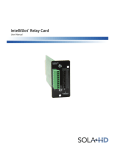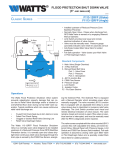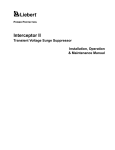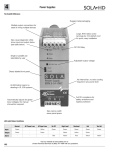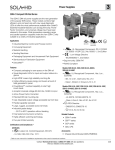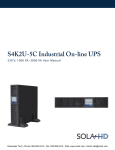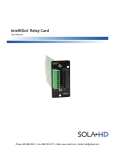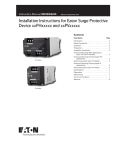Download Emerson 400K Specification Sheet
Transcript
Surge Protective Device STV200/400K Series Instruction Manual Contents 1.0 Introduction.................................................................................................................... 4 2.0 Warnings Defined........................................................................................................... 4 3.0 Preinstallation................................................................................................................ 5 3.1 Unpacking & Preliminary Inspection............................................................................................ 5 3.2 Storage........................................................................................................................................ 5 3.3 Location Considerations.............................................................................................................. 5 3.4 Electrical Connections................................................................................................................. 6 3.5 Voltage Ratings & Power Source Configurations......................................................................... 6 3.6 Parallel Connection...................................................................................................................... 7 3.7 Proper Connection of SPDs......................................................................................................... 8 3.8 System Grounding & Bonding...................................................................................................... 9 3.9 SPD Monitoring.......................................................................................................................... 10 3.10SPD Interconnect Assembly...................................................................................................... 10 4.0 Installation.................................................................................................................... 12 5.0 Dimensions................................................................................................................... 14 6.0 Specifications............................................................................................................... 15 7.0 Maintenance & Service................................................................................................ 16 7.1 Corrective Maintenance............................................................................................................. 16 7.2 Preventative Maintenance......................................................................................................... 16 7.3 Service....................................................................................................................................... 16 8.0 Troubleshooting........................................................................................................... 17 9.0 Registration & Warranty.............................................................................................. 17 9.1 Product Registration.................................................................................................................. 17 9.2 Warranty Information.................................................................................................................. 17 While every precaution has been taken to ensure accuracy and completeness in this manual, EGS Electrical Group, LLC. assumes no responsibility, and disclaims all liability for damages resulting from use of this information or for any errors or omissions. The SolaHD and Emerson logos are registered in the U.S. Patent and Trademark Office. All other product or service names are the property of their registered owners. ©2011 EGS Electrical Group, LLC. All rights reserved. Specifications are subject to change without notice. 1.0 Introduction The SolaHD STV200/400K Series surge protective devices (SPDs) offer continuous protection from electrical noise and high-impulse, potentially damaging transients commonly found at the service entrance or distribution panel. The modular, robust design provides installation flexibility, while allowing placement in the most severe exposure locations. Proper installation is required for maximum system performance. To ensure a quality installation, the installer should read the entire manual and follow all instructions before and during the installation. These instructions do not replace national or local electrical codes. Check applicable electrical codes to ensure compliance. Installation of the STV200/400K Series should be performed by qualified personnel. 2.0 Warnings Defined ! Danger! Indicates an imminently hazardous situation that, if not avoided, will result in death or serious injury. This signal word is limited to the most extreme situations. ! WARNING! Indicates a potentially hazardous situation that, if not avoided, could result in death or serious injury. ! caution! Indicates a potentially hazardous situation that, if not avoided, may result in minor or moderate injury. It may also be used to alert against unsafe practices. STV200/400K Instruction Manual • 4 3.0 Preinstallation 3.1 Unpacking & Preliminary Inspection 1. Inspect the shipping crate(s) for damage or signs of mishandling before unpacking the unit. 2. Remove any securing bands and cardboard packing and inspect the unit for any obvious shipping damage. 3. If any shipping damage is observed, immediately file a claim with the shipping agency and forward a copy to your SolaHD Representative. 3.2 Storage The unit should be stored in a clean, dry environment. The storage temperature range is -55°C to +85°C (-67°F to +185°F). Care should be taken to avoid condensation. All packing and shipping materials should be left intact until the unit is ready for final installation. If the unit has been stored for an extended period of time, it should be cleaned and carefully inspected before placing into service. 3.3 Location Considerations Environment: The unit is designed for indoor operation in an ambient temperature range of -40°C to +60°C (-40°F to +140°F) with a relative humidity of 0% to 95% non-condensing. The unit is provided in an industrial-use enclosure, which is dust-tight and driptight. It should not be installed in areas with excessive dust, corrosive vapors, flammable materials, or explosive atmospheres. Audible Noise: The audible noise of the unit is less than 40 dB at 5 feet, which allows placement within most rooms (if desired). Service Clearance: 36 inches (914 mm) minimum is recommended for units with hinged doors that open to the front. Mounting: The unit is intended to be wall mounted. See Figure 4 for dimensions. Tip: To maximize system performance, locate the unit as close as possible to the protected circuit and keep interconnecting wiring less than 5 feet. For optimum transient surge protection, coordinated surge suppression should be applied at the service entrance and all other electrical connections to the building (e.g. telephone, CATV); also at known surge generating loads within the building (e.g. large motors, arc welders, switched capacitors); as well as sensitive electronic loads (e.g. computers, electronic appliances, solid state motor drives). For interconnected electronic loads (by the way of data cabling), transient surge suppression should also be applied to the interconnecting wiring (data cables). STV200/400K Instruction Manual • 5 3.4 Electrical Connections ! Danger! Verify that all power circuits are de-energized and locked out before making electrical connections. All electrical connections must be installed by a licensed electrician and all wiring must comply with the National Electrical Code (NEC) and applicable local codes. 3.5 Voltage Ratings & Power Source Configurations ! caution! Before making connections to the unit, verify that the unit model number and nameplate voltage rating are appropriate for connection to the intended power source. See Table 1 for voltage ratings and power source configurations. Table 1: Voltage Ratings & Power Source Configurations Source Configurations Nominal Operating Voltage L–N 3-phase Wye 4 W + G A L–G L–L Maximum Continuous Voltage L–N L–G N–G L–L Model Voltage Code (found in part #) 120 V 120 V 208 V 150 V 150 V 150 V 300 V 10Y 277 V 277 V 480 V 320 V 320 V 320 V 640 V 27Y N B C G 3-phase Delta 3 W + G A N/A 480 V 480 V N/A 580 V N/A 640 V 48D B C G STV200/400K Instruction Manual • 6 3.6 Parallel Connection To reduce the wiring impedance to surge currents, it is recommended that the phase, neutral (if required), and ground conductors are twisted together and routed in the same raceway (conduit). Avoid any sharp bends in the conductors. Tip: To maximize system performance, locate the unit as close as possible to the protected circuit and keep interconnecting wiring less than 5 feet. Wire Sizing: With parallel connection, the size of the wiring to the SPD unit is independent of the protected circuit’s ampacity. For suggested wire size, refer to Table 2. NOTE: NEC Article 285-26 requires surge suppressor connecting conductors to be at least #14 AWG copper or #12 AWG aluminum. Overcurrent Protection: The SPD unit conducts minimal current under normal operation and very short duration transient surge currents. Disconnect Switch (if provided): All SPD units must be connected to the load side of the main service disconnect or the load side of a protected circuit’s disconnecting means. Neutral Phases Ground To Protected Loads Neutral Phase(s) SolaHD Surge Protective Device Transient Ground Protected Panel Wire should be less than 5 feet and as straight as possible Safety Ground Figure 1: Typical parallel connection without internal rotary disconnect STV200/400K Instruction Manual • 7 Neutral Phases Ground To Protected Loads Neutral Rotary Disconnect Phase(s) SolaHD Surge Protective Device Transient Ground Protected Panel Wire should be less than 5 feet and as straight as possible Safety Ground Figure 2: Typical parallel connection with internal rotary disconnect Voltage Protection Ratings (VPRs): To obtain the Voltage Protection Ratings (VPRs) as obtained by Underwriters Laboratories, Incorporated, in accordance with ANSI/UL 1449 Third Edition, the Standard for Safety, Surge Protective Devices (SPDs), the wire size listed for each product must be utilized to connect the unit to your facilities’ power grid. Connections made with conductors other than the wire size listed may result in different VPRs. Circuit Ampacity Limitations: Representative samples of these products have been investigated by Underwriters Laboratories, Incorporated, to withstand without exposing live circuits or components at system voltages and fault currents up to 200,000 AIC, as described in ANSI/UL 1449 Third Edition, the Standard for Safety, Surge Protection Devices (SPDs). Verify each product’s fault current rating on the installation pages that follow. 3.7 Proper Connection of SPDs Type 1 SPDs shall be installed as defined in the National Electrical Code (NEC) 2011 Edition as follows: 285.23 Type 1 SPDs (Surge Arresters). Type 1 SPDs shall be installed in accordance with 285.23(A) and (B). STV200/400K Instruction Manual • 8 A) Installation. Type 1 SPDs (surge arresters) shall be installed as follows: 1) Type 1 SPDs (surge arresters) shall be permitted to be connected to the supply side of the service disconnect as permitted in 230.82(4) or 2) Type 1 SPDs (surge arresters) shall be permitted to be connected as specified in 285.24. B) At the Service. When installed at services, Type 1 SPDs shall be connected to one of the following: 1) Grounded service conductor 2) Grounding electrode conductor 3) Grounding electrode for the service 4) Equipment grounding terminal in the service equipment 3.8 System Grounding & Bonding The performance and safety of any SPD is dependent on proper grounding and bonding. Grounding is required for safety; correct implementation also enhances equipment performance. Incorrect grounding can reduce or impede the SPD’s operation. All electrical circuits to the SPD must include an equipment-grounding conductor as required by the NEC and local codes. An insulated grounding conductor is required in addition to any metallic raceway, which may be used as a grounding conductor. For parallel connected SPDs, the grounding conductor should be the same wire size as the associated power conductors. Grounding conductors must be routed with the associated power conductors in the same raceway (conduit). When metallic raceways are used, adequate electrical continuity must be maintained at all raceway connections, particularly raceway terminations to the electrical enclosures. The use of isolating bushings or other means to interrupt a metallic conduit run is a potential safety hazard and is not recommended. Grounding Electrode: Surge protective devices do not discharge all surges to ground (earth). Surge protective devices divert the surge current back to its source to complete the electrical circuit. In the case of lightning where potential is developed with respect to the earth, the SPD diverts the surge current to the grounding electrode (earth connection). However, for most transient surges that are developed by switching loads, the SPD diverts the surge current back to its source without involving the grounding electrode. For proper SPD performance, the service entrance grounding electrode system must comply with the NEC by having all available electrodes (building steel, metal water pipe, driven rods, concrete encased electrodes, etc.) properly bonded together and connected to the power system grounding. The use of a separate grounding electrode to ground the SPD defeats the effectiveness of the unit, is a potential safety hazard, may cause equipment damage, and is an NEC violation (reference NEC 250.50). System Neutral: For proper and safe operation, the neutral (if provided) must be reliably connected to the neutral of the source. Failure to provide a reliable neutral connection may result in SPD module failure. STV200/400K Instruction Manual • 9 3.9 SPD Monitoring External Status Indicators: These indicators provide a summary of the status of the SPD module. For normal conditions, the green “OK” LED is illuminated and the red “Service” LED is off. If the SPD module requires replacement, the green “OK” LED is turned off and the red “Service” LED is illuminated. Summary Alarm Contact: Summary alarm Form C relay contacts are provided for remote indication of a failed SPD module. Contacts are rated 5 A at 250 V ac maximum with a power factor of 1.0. Access to the contacts are typically provided via contact terminals located on the printed circuit board (mounted on the inside of the unit’s cover). Transient Counter (optional): Transient counters are provided for transient voltage surge monitoring. The counter totalizes surges monitored since the last counter reset. The transient counter monitors line transient voltages. The circuit counts all surges that deviate from the line sine wave. The factory setting is 30% over nominal line voltage. Other settings include 50%, 70%, and 100%. Audible Alarm: If the SPD module requires replacement, an audible alarm is activated. An audible alarm disable is provided to silence the alarm. The system will automatically reset itself after repair. The audible alarm switch and “Service” LED can be tested by activating the “Test” switch on the system monitor panel. 3.10 SPD Interconnect Assembly Installation Instructions: All electrical connections shall be installed by a licensed electrician. All wiring must comply with the National Electrical Code (NEC) and applicable local codes. National Electrical Code (NEC) Considerations: The NEC Article 240-21 details specific tap rules that should be considered before installation. NEC 240.21 Location in Circuit. Overcurrent protection shall be provided in each ungrounded circuit conductor and shall be located at the point where the conductors receive their supply except as specified in 240.21(A) through (H). Conductors supplied under the provisions of 240.21(A) through (H) shall not supply another conductor except through an overcurrent protective device meeting the requirements of 240.4. A) Branch-Circuit Conductors. Branch-circuit tap conductors meeting the requirements specified in 210.19 shall be permitted to have overcurrent protection as specified in 210.20. B) Feeder Taps. Conductors shall be permitted to be tapped, without overcurrent protection at the tap, to a feeder as specified in 240.21(B)(1) through (B)(5). The provisions of 240.4(B) shall not be permitted for tap conductors. STV200/400K Instruction Manual • 10 1) Taps Not Over 3 m (10 ft.) Long. If the length of the tap conductors does not exceed 3 m (10 ft.) and the tap conductors comply with all of the following: 1) The ampacity of the tap conductors (25 A in our case) is a. Not less than the combined calculated loads on the circuits supplied by the tap conductors, and b. Not less than the rating of the device supplied by the tap conductors or not less than the rating of the overcurrent protective device at the termination of the tap conductors. 2) The tap conductors do not extend beyond the switchboard, panel board, disconnecting means, or control devices they supply. 3) Except at the point of connection to the feeder, the tap conductors are enclosed in a raceway, which shall extend from the tap to the enclosure of an enclosed switchboard, panel board, or control devices, or to the back of an open switchboard. 4) For field installations, if the tap conductors leave the enclosure or vault in which the tap is made, the ampacity of the tap conductors is not less than one-tenth of the rating of the overcurrent device protecting the feeder conductors. 2) Taps Not over 7.5 m (25 ft.) Long. Where the length of the tap conductors does not exceed 7.5 m (25 ft.) and the tap conductors comply with all of the following: 1) The ampacity of the tap conductors is not less than one-third of the rating of the overcurrent device protecting the feeder conductors. (75 A maximum in our case.) 2) The tap conductors terminate in a single circuit breaker or a single set of fuses that limit the load to the ampacity of the tap conductors. This device shall be permitted to supply any number of additional overcurrent devices on its load side. 3) The tap conductors are protected from physical damage by being enclosed in an approved raceway or other approved means. 3) Taps Supplying a Transformer. Not Applicable for this product. 4) Taps Over 7.5 m (25 ft.) Long. Not Applicable for this product. 5) Outside Taps of Unlimited Length. Not Applicable for this product. Flexible, liquid-tight, non-metallic conduit in lengths greater than 6 feet must be installed in accordance with NEC Article 350. STV200/400K Instruction Manual • 11 4.0 Installation 1. Ensure that all power is removed before beginning installation. A qualified, licensed electrician shall install all electrical connections. 2. The STV200/400K is provided in a UL Listed Type/NEMA 12 enclosure which is suitable for indoor installations. Optional UL Listed Type/NEMA 3R, 4 or 4X enclosures are suitable for indoor or outdoor applications. 3. Determine the mounting location. Allow for minimum length of wire between the unit and the input power terminals of the service panel. 4. Punch or cut the proper hole size in the side of the STV200/400K closest to the service panel. 5. Drill mounting holes in the wall. Mount the unit using ¼ in. mounting hardware. 6. An external circuit breaker is not necessary for overcurrent protection for most units, however, it is recommended that the SPD be connected in series with a circuit breaker (see Table 2). The SPD shall be connected in accordance with all national and local electrical codes. 7. Connect the black wires (line or phase) marked L1/A, L2/B, or L3/C; the white wire (neutral) marked N; and the green wire (ground) marked G. See Figure 3. Refer to Table 2 for suggested wire sizes. ! caution! If the SPD model is a Wye configured unit (4 W + G) and a neutral connection is not available, please contact SolaHD Technical Support for assistance. Tip: To yield the best performance of the SPD within the electrical distribution system, keep all conductors as short as possible and avoid sharp bends. 8. If using the Summary Alarm Contacts for remote indication, connect with #18–22 AWG. Contacts are rated 5 A at 250 V ac (maximum) with a power factor of 1.0. See Figure 3. 9. Apply power. The surge protector is fully operational when the front door of enclosure and the green LEDs on the modules are illuminated. If the green LEDs are extinguished or a red LED is illuminated, check to ensure that power is applied to the SPD. If an abnormal indication is present, remove power to the SPD and contact SolaHD Technical Support at (800) 377- 4384. NOTE: Periodically monitor the status of the LEDs. Reduced protection exists if the green LEDs are extinguished or the red LED is illuminated. STV200/400K Instruction Manual • 12 Table 2: Installation Specifications Suggested Breaker Size Suggested Wire Size AWG Allowable Breaker Range Allowable Wire Range 8.25 x 14.25 x 16.25 40 A #8 15–100 A #14–2 8.25 x 14.25 x 16.25 100 A #2 15–100 A #14–2 Suggested Breaker Size Suggested Wire Size AWG Allowable Breaker Range Allowable Wire Range Model Weight lb. (kg) Dimensions D x W x H (in.) STV200K 35 (15.88) STV400K 42 (19.05) Units with Rotary Disconnect Model Weight lb. (kg) Dimensions D x W x H (in.) STV200K 38 (17.23) 8.25 x 14.25 x 16.25 40 A #8 15–175 A #14–2/0 STV400K 45 (20.41) 8.25 x 14.25 x 16.25 100 A #2 15–175 A #14–2/0 Service Panel for Loads to be Protected Dedicated Disconnect (Optional) Phase L1/A Phase L2/B Phase L3/C Disconnect/Main Breaker for Panel Neutral Bus Ground Bus Recommended Wire Entrance Summary Alarm Contacts (x2) Pin 1 = Normally Open Pin 2 = Common Pin 3 = Normally Closed TB1 1 2 3 1 2 3 TB2 Figure 3: Installation drawing STV200/400K Instruction Manual • 13 5.0 Dimensions 14.25 8.25 16.75 0.31 16.25 12.00 1.30 max. Figure 4: Dimensional drawing STV200/400K Instruction Manual • 14 6.0 Specifications Table 3: Technical Specifications Parameters Input Voltage Catalog Number STV200K10Y STV200K27Y 120Y/208 V 3Ph Wye, 4W+G Maximum Continuous Operating Voltage (MCOV) STV200K48D STV400K10Y STV400K27Y STV400K48D 277Y/480 V 480 V 120Y/208 V 277Y/480 V 480 V 3Ph Wye, 4W+G 3Ph Delta, 3W+G 3Ph Wye, 4W+G 3Ph Wye, 4W+G 3Ph Delta, 3W+G 125% of the nominal level for 120 V; 115% for all other voltages Line Frequency 47–63 Hz Response Time < 0.5 ns Enclosure Metal, UL Listed Type/NEMA 12 (NEMA 3R, 4, 4X also available) Mounting Type Wall Mounted (mounting hardware ¼ in.) Connection Internally connected Status Indication Red and green LED status indicators, audible alarm, summary alarm contacts Operating Temperature -40°C to +50°C Operating Humidity 0% to 95% non-condensing Noise Attenuation 50 dB Maximum Modes of Protection All Modes: L–N, L–L, L–G, N–G* AIC Rating 200 kAIC Nominal Discharge Current Rating (In) 20 kA Safety Agency Approvals UL 1449, Third Edition, Type 1 Warranty 5 year limited warranty UL 1449, Third Edition, Type 1 Voltage Protection Ratings (VPRs) Line to Neutral 800 V 1200 V N/A 700 V 1200 V N/A Line to Line 1200 V 2000 V 2000 V 1200 V 1800 V 2000 V Line to Ground 900 V 1200 V 1800 V 800 V 1200 V 1800 V Neutral to Ground 700 V 1000 V N/A 700 V 1000 V N/A 400 kA Peak Surge Current Capability Per Phase 200 kA 400 kA 200 kA 400 kA 200 kA Line to Neutral 100 kA 200 kA N/A 200 kA 100 kA N/A Line to Line 100 kA 200 kA 100 kA 200 kA 100 kA 200 kA Line to Ground 100 kA 200 kA 100 kA 200 kA 100 kA 200 kA Neutral to Ground 100 kA 200 kA N/A 200 kA 100 kA N/A *Delta Model does not offer N–G mode of protection STV200/400K Instruction Manual • 15 7.0 Maintenance & Service ! danger! Only qualified personnel should perform maintenance on this system. Hazardous voltages are present inside the unit during normal operation. Electrical safety precautions must be followed when servicing this unit. To prevent risk of electrical shock, turn off and lock out all power sources to the unit before servicing. 7.1 Corrective Maintenance The SPD is designed for years of trouble-free operation, but even the most reliable equipment may fail under abnormal conditions. Diagnostic indicators are provided to indicate when the unit needs to be repaired. To ensure continuity of surge protection, failed units should be replaced as soon as possible. When replacing surge modules, other components should be inspected for damage and replaced if necessary. Standard electrical troubleshooting procedures should be used to isolate other problems. When replacing components—for continued proper operation and safety—only use identically rated components. For more information on replacement parts, please contact SolaHD Technical Support at (800) 377-4384 or (847) 268-6651. 7.2 Preventative Maintenance Periodic system inspections, cleaning, and connection checks are recommended to ensure reliable system performance and continued surge transient protection. 7.3 Service For service assistance, contact SolaHD Technical Support at (800) 377-4384 or (847) 268-6651 or by e-mail at [email protected]. STV200/400K Instruction Manual • 16 8.0 Troubleshooting If status failure indication occurs or Form C relay has changed states, a licensed electrician shall first determine if the system’s voltage and proper phasing exists. If it remains in an alarm condition once the electrician is satisfied that the electrical system and its connections are normal, the unit should be repaired. Please contact SolaHD Technical Support at (800) 377-4384 or (847) 268-6651 or by e-mail at [email protected] for further assistance. When contacting SolaHD, please have the following information available: 1. Unit identification number, which is located on the front or upper left side of the enclosure. 2. The nature of problem, including status of all indicators and alarms. 9.0 Registration & Warranty 9.1 Product Registration To register your product for updates and information on service and support, visit our Web site at: http://www.solahd.com/support/registration.htm. 9.2 Warranty Information Please see “Terms & Conditions of Sale”. STV200/400K Instruction Manual • 17 www.solahd.com (800) 377- 4384 • (847) 268-6651 [email protected] Part Number: A272-157 Rev 5 April 2011





















![7月号 [8504KB pdfファイル]](http://vs1.manualzilla.com/store/data/006682762_2-234d652d70dc837ab02de50595af3319-150x150.png)
